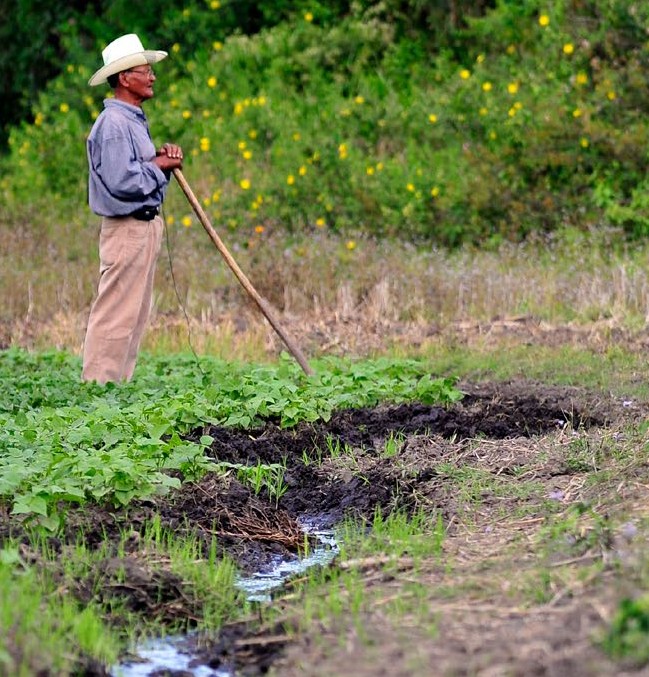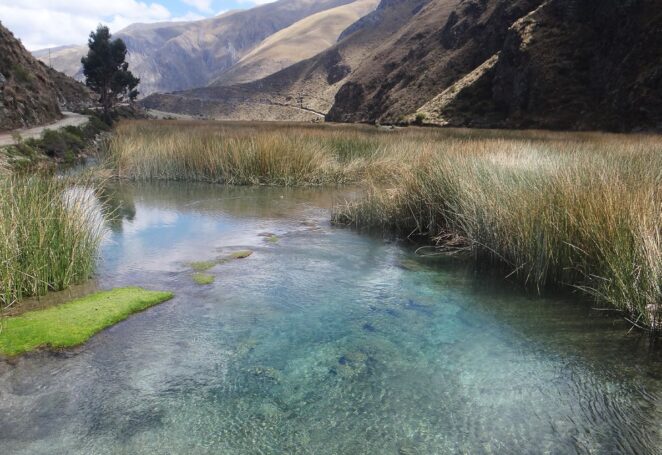Integrating ecosystem-based adaptation and integrated water resources management for climate-resilient water management

Introduction
The world’s water resources are under increasing pressure due to growing water demands as well as an ongoing degradation of the global water resources. Climate change is expected to worsen this situation in most regions of the world. The water sector is vital for human well-being and sustainable development and crucial to other economic sectors, such as agriculture and industry. However, it is also highly vulnerable to climate change. Thus, sustainable water management is a top priority in climate adaptation planning and implementation, as expressed through numerous global and national strategic key documents.
The resilience in watersheds greatly depends on healthy ecosystems and their services. Healthy ecosystems support natural water storage and retention, reduce impacts of extreme events and contribute to water purification through bio-chemical and bio-physical processes. This increases water availability in adequate quality, and overall it also contributes to water security despite increasing pressures on global water resources due to climate change and development..
Coupling ecosystem-based adaptation (EbA) and integrated water resources management (IWRM) approaches could maximise opportunities to increase resilience in watersheds. The study aims to analyse how these two concepts can be merged in practice.
*An overview of the publication is provided below. See the full text for much more detail. You can also watch the video above for further introduction to the study.
Structure and methodology
The publication entails a conceptual analysis of both approaches and showcases nine practical implementation examples of integrated EbA-IWRM projects around the world. These examples come from the platform ‘PANORAMA – Solutions for a Healthy Planet’, and include case studies in:
- Peru – the Chira-Piura River Basin, on water funds to mainstream EbA into IWRM;
- Tanzania/Kenya – the Mara River Basin, on environmental flow assessment for transboundary and climate-resilient IWRM;
- Thailand, on anchoring EbA in water sector policies and river basin planning;
- Philippines, integrating EbA in water sector planning and implementation in watersheds;
- Democratic Republic of Congo, on Eco-Disaster Risk Reduction through IWRM;
- Burundi, on resilient management of water and soil resources;
- Tajikistan, on Integrated Disaster Risk Reduction in flood-affected areas;
- Mexico, on a dynamic tool for integrated land use and water management;
- Costa Rica/Panama, on governance for adaptation in the transboundary Sixaola River Basin.
The case studies reveal structural similarities, key lessons, and enabling and inhibiting factors for integrated EbA-IWRM approaches. From this, the study derives and promotes a set of guiding principles for integrated EbA-IWRM projects. These principles encompass features for designing new, coupled EbA-IWRM projects and also elements for inclusion and enhancement of ongoing water and/ or conservation projects. The way forward outlines the need to further advance conceptual thinking on integrating IWRM and EbA for climate-resilient water management. It also illustrates increased practical experiences of coupled approaches around the world.
* See the full text for much more detail on each case-study.
Guiding principles for integrated EbA-IWRM project design
The proposed set of guiding principles consists of three strategic lines: a) understand, acknowledge and shape the settings for coupled ecosystem-based adaptation and integrated water resources management approaches, b) develop shared concepts of ecosystem-based adaptation and integrated water resources management, and c) develop (practical) tools and mechanisms.
A.1. Understand and acknowledge the politics, be patient and assign time
- Understand and accept the political nature of IWRM and EbA.Political will is the key to the success of IWRM and EbA implementation.
- If required, work towards policy and sector harmonisation: high numbers of development plans, policies and strategies can hamper coupled EbA-IWRM approaches.
- Be patient and assign time.To develop relationships and trust as the basis for collaboration in complex and contested settings needs time.
A.2 Apply a multi-level approach
- Shape the settings by merging top-down with bottom-up approaches.Successful integration of EbA with IWRM ideally occurs simultaneously at different levels and is based on the needs of communities. This requires institutional leadership at all levels.
A.3 Develop EbA entry points
- EbA mainstreaming requires enabling settings. These can be developed by supporting national and sectoral policy development or establishing tools and mechanisms that can cater for EbA implementation, such as water funds or Environmental Flow Assessments.
A.4 Ensure willingness and ownership for coupled EbA-IWRM approaches
- The direct experience of climate change impacts on local waterresources increases the willingness of stakeholders to try EbA as a new approach.
B.1 EbA within IWRM is fairly new – facilitate capacity building towards shared concepts
- Capacity building facilitation needs to include theoretical and practical elements, through data collection, communication and workshops, and through active involvement in practical and hands-on implementation of pilot and demonstration measures.
- Construction companies often lack skills in designing and implementing ‘green’ EbA measures. Capacity building also needs to focus on the private construction sector.
B.2 Select the appropriate scale
- Introducing merged EbA-IWRM approaches at smaller River Basins, compared to contested and politicised large-scale basins, is considered by practitioners as the more appropriate scale.
C.1 Work with River Basin organisations and assure participation and inclusivity
- Working in watersheds together with established River Basin committees or water user associations enables the introduction of coupled EbA-IWRM approaches.
- Informal structures can be supportive: if no (formal) basin committee is in place and the local situation does not allow the establishment of a (new) basin committee,informal gatherings of groups from upstream and downstream can also facilitate collaboration across stakeholders and sectors within a basin.
- Established structures can be weak, have lost the full representation of stakeholders and lack acceptance and trust by communities. Institutional strengthening of existing basin organisations is required in the first place.
C.2 Implement pilot and demonstration projects
- Get practical! The implementation of pilot and demonstration measures is crucial to experience and showcase the effects and benefits of EbA-IWRM. Capacity building measures, as a key to EbA, must provide for action learning and include implementation of pilot measures on the ground.
C.3 Develop sustainable financing mechanisms for EbA
- Upscaling requires independent and long-term funding mechanisms: Funding is often confined to implementation and demonstration measures. Enabling upscaling of successful approaches requires the establishment of independent, long-term funding mechanisms.
C.4 Invest into Monitoring and Evaluation
- It needs to be proven that ecosystem-based solutions are cost-effective and flexible options for climate-resilient water management. Developing and implementing Monitoring and Evaluation systems supports knowledge generation on the impact and effectiveness of measures
Key messages
- Considering the vital importance of water security for human well-being, IWRM is at present not going far enough to safeguard human well-being and ecosystem health.
- The noted lack of anchoring systematic climate proofing within IWRM-principles and mechanisms, and the need to focus on ecosystem-based approaches to achieve water security in the face of climate change both call for an integration of the approaches.
- To aim for water security as a basis for human well-being, sustainable economic development and ecosystem health, coupled EbA-IWRM approaches need to (a) assure systematic climate proofing of water projects and (b) mainstream and prioritise EbA approaches to support climate resilience and water security in watersheds as means to adapt to climate change.
- EbA as a new approach: implementing coupled EbA-IWRM projects often provides a new approach to climate resilience, compared to conventional, well-known and accepted grey infrastructure solutions. Introducing EbA requires intensive capacity building measures at all levels.
- Work with what you have: examples show that even in settings of limited financial and time-related resources, EbA can be merged with IWRM and can facilitate joint action.

This publication was produced in the context of theGlobal Project Mainstreaming EbA, a project funded by BMU-IKI and implemented by GIZ.
Suggested citation
GIZ (2021) Integrating EbA and IWRM for climate-resilient water management. Deutsche Gesellschaft für Internationale Zusammenarbeit (GIZ) GmbH, Bonn, Germany.
Further reading
Related resources
- Guidebook for Monitoring and Evaluating Ecosystem-based Adaptation Interventions
- Building Resilience With Nature: Ecosystem-based Adaptation in National Adaptation Plan Processes
- Stakeholder-Based Development Planning of the Shire River Basin’s Water and Natural Resources in Southern Malawi
- Using climate information for Climate-Resilient Water Management: Moving from science to action
- ALivE - Adaptation, Livelihoods, and Ecosystems Planning Tool
(0) Comments
There is no content